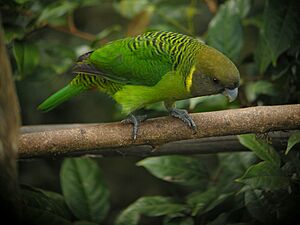Brehm's tiger parrot facts for kids
Brehm's tiger parrot, also known as Brehm's ground parrot, is a small, mostly green parrot. You can find these colorful birds in the high mountains of New Guinea. They usually live at altitudes between 1,500 and 2,600 meters (about 4,900 to 8,500 feet). This special parrot is named after Alfred Brehm, a German explorer and collector from the 1800s.
Quick facts for kids Brehm's tiger parrot |
|
|---|---|
 |
|
| Male in Papua New Guinea | |
 |
|
| Female in Papua New Guinea | |
| Conservation status | |
| Scientific classification | |
| Genus: |
Psittacella
|
| Species: |
brehmii
|
Contents
Brehm's Tiger Parrot: A Closer Look
Different Kinds of Brehm's Tiger Parrots
Just like people can have different looks depending on where they live, animals can have different types too. These are called subspecies. There are four known subspecies of Brehm's tiger parrot. They live in three different areas:
- P. b. brehmii: This type lives in the Bird's Head Peninsula area of West Papua.
- P. b. intermixta: You can find this one in the central highlands of New Guinea. It is larger and has more yellowish-green colors on its belly and back.
- P. b. pallida: This subspecies lives in the southeastern highlands of New Guinea. It looks like the first type but has a thinner beak.
- P. b. harterti: This type is found in the Huon Peninsula in northeastern New Guinea. It has a lighter head and less yellowish-green color. It is also smaller.
These parrots are often seen alone or in small groups. They like to eat seeds and berries. They usually look for food in the lower parts of trees or close to the ground.
What Do Brehm's Tiger Parrots Look Like?
Brehm's tiger parrot is the biggest parrot in its group, called Psittacella. It is about 24 centimeters (9.4 inches) long. It weighs between 94 and 120 grams (about 3.3 to 4.2 ounces).
Most of its body is green. Its head is a dull olive-brown color. It has cool yellow and black stripes across its back and rump. The feathers under its tail are red. Its eyes are red, and its beak is bluish-grey with a white tip. Its legs are grey.
Males, Females, and Young Parrots
- Males have a yellow stripe on the sides of their neck. Their chest is green and does not have stripes.
- Females do not have the yellow stripe on their neck. Their chest has yellow and black stripes.
- Young parrots look a lot like females. However, their eyes are yellowish-brown. The stripes on their chest are also a lighter green and pale-yellow.
These parrots are usually very quiet. They are rarely kept as pets because they are very delicate. They need their natural mountain home to stay healthy and happy.


